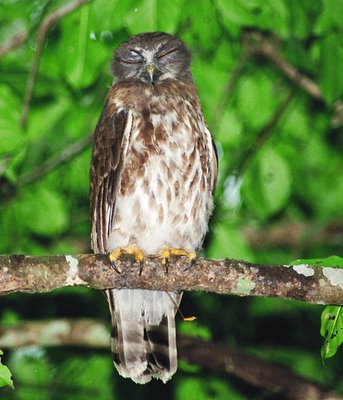Saturday, December 31, 2005
Friday, December 30, 2005
circumspice ...
Thursday, December 29, 2005
H20 ...
Wednesday, December 28, 2005
hokku or haiku ? ...

there is nothing you can see that is not a flower, there is nothing you can think that is not the moon
Tuesday, December 27, 2005
same fella ...
Monday, December 26, 2005
Sunday, December 25, 2005
primordial soup ...
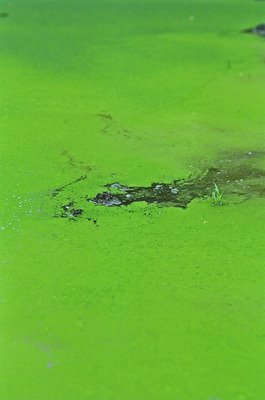
historical radius of the spherical universe we can observe, is about 78 billion light years. we cannot observe anything outside that sphere, as information from it would have taken longer to reach us than the life of the universe ! the universe, which includes time, space, and everything in it, begins with the big bang 13.7 ± 0.2 billion years ago.
probably all of the organic beings which have ever lived on this earth have descended from some one primordial form, into which life was first breathed. the species we see today are but the smallest part of what blind destiny has produced, all living species of today are related to each other through common descent, products of evolution and speciation over billions of years.
human DNA sequences are approximately 6.6% divergent from those of their nearest genetic relative the baboons, 1.6% from gorillas , and 1.2% from chimpanzee, 0.1 % between you and me.
Thursday, December 22, 2005
koo-ook...koo-ook ...ook ...
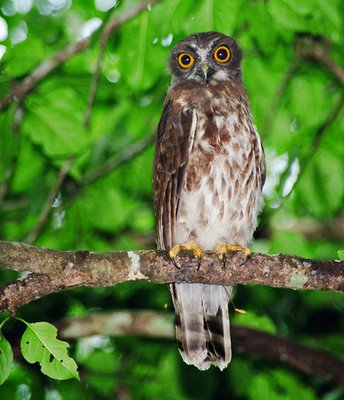
the brown hawk owl, ninox scutulata, is a resident breeder in tropical south asia. this species is a part of the larger grouping of owls known as typical owls, strigidae, which contains most species of owls, the other grouping are the barn owls, tytonidae.
it is a medium-sized (32cm) owl with a hawk-like shape due to its long tail and lack of a distinct facial disk. the eyes are large and yellow. sexes are similar. it lays three to five eggs in a tree hole. this species is very nocturnal. It feeds mainly on large insects, frogs, lizards, small birds, and mice. the call is a soft, musical koo-ook...koo-ook ...
Wednesday, December 21, 2005
koo-ook...koo-ook ...
Tuesday, December 20, 2005
my relatives in seychelles ...
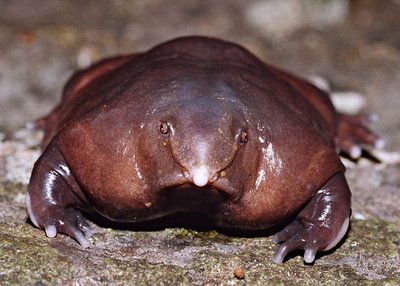
" it is while you are patiently toiling at the little tasks of life that the meaning and shape of life dawns on you "
Monday, December 19, 2005
now think again ...
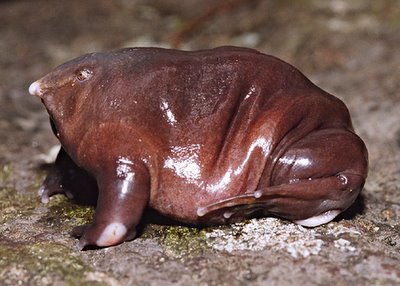 nasikabatrachus sahyadrensis is a frog species ! from the western ghats, india. it was discovered in 2003 and forms its own family ! common names for this species are purple frog or pignose frog. the scientific name derived from the word nasika - nose in sanskrit, batrachus - frog in greek, and sahyadri as the local name of the mountain range where it was found.
nasikabatrachus sahyadrensis is a frog species ! from the western ghats, india. it was discovered in 2003 and forms its own family ! common names for this species are purple frog or pignose frog. the scientific name derived from the word nasika - nose in sanskrit, batrachus - frog in greek, and sahyadri as the local name of the mountain range where it was found. Sunday, December 18, 2005
flying frog ...
the origin of novel phenotypes has challenged evoluionary biologists since the time of darwin. darwin's theory of evolution provides an explanation for how natural selection eliminates the less fit phenotypes, but leaves open the question of how novel phenotypes arise !
rhacophorus malabaricus is a large-sized tree frog endemic to the western ghats of india. inhabits evergreen, and semi-evergreen forests and builds arboreal foam nests. gliding tree frogs have features such as enlarged, extensively webbed hands and feet with adhesive discs, skin flaps on elbows and ankles. these frogs use gliding to descend from the canopy down to mating sites over temporary pools on the rainforest floor and to escape from predators.
aerodynamic stability and maneuverability
the motion an animal experiences during flight is marked by transitory oscillations (phugoid mode, short-period mode, Dutch-roll mode and spiral mode) superimposed over translation along a flight path. In addition, the flight path may be changing as a result of postural changes by the animal.
maneuverability is the ability of a gliding animal to accelerate and change its flight path. a gliding animal is capable of accelerating linearly and rotationally. turning maneuvers are accomplished by rotations about the glider's center of mass that in turn alter the aerodynamic forces acting on the glider. maneuverability depends on the magnitude of the aerodynamic forces the frog can generate as well as the frog's aerodynamic stability.
 this rotation can be resolved into rotations about three orthogonal axes, pitch, roll and yaw. the origin of the axes is fixed to the animal's center of mass, and the axes themselves are fixed to the animal; the axes translate and rotate as the animal translates and rotates. (A) rotation about the cranial-caudal axis is termed roll angle, rolling rotates the animal's right side up or down. (B) rotation about a dorso-ventral axis is termed yaw angle, yawing rotates the animal's snout to the left or right. (C) rotation about a lateral axis is termed angle of attack, pitching rotates the animal's snout up or down. grey arrows indicate the directions of the indicated torques.
this rotation can be resolved into rotations about three orthogonal axes, pitch, roll and yaw. the origin of the axes is fixed to the animal's center of mass, and the axes themselves are fixed to the animal; the axes translate and rotate as the animal translates and rotates. (A) rotation about the cranial-caudal axis is termed roll angle, rolling rotates the animal's right side up or down. (B) rotation about a dorso-ventral axis is termed yaw angle, yawing rotates the animal's snout to the left or right. (C) rotation about a lateral axis is termed angle of attack, pitching rotates the animal's snout up or down. grey arrows indicate the directions of the indicated torques.
tree frogs maneuvered in the tilted wind-tunnel using two different turning mechanisms: a banked turn (the frog rolls into the turn) and a crabbed turn (the frog yaws into the turn). the maneuverability was approximately one-third of the maneuverability of a falcon.
thank u so much for your wonderfull research MICHAEL G. McCAY
Saturday, December 17, 2005
bufo camo ...

frogs and toads comprise the order anura. there are about 3,500 known species of frogs and 400 kinds of toads, still plenty being discovered every day. they are found on every continent except antarctica. they are very sensitive to climate change, thus called as an indicator species and their population is declining rapidly. the word "frog" can be used to describe all stout bodied amphibians, smooth and moist skinned, that have long hind limbs for leaping.
Friday, December 16, 2005
re ..re...ree...reeee...re..reee...

Thursday, December 15, 2005
nephila maculata ...

spider silk is tough, stronger (upto 5oo % ) than steel and more elastic (up to 300 %) than anything else we can make is surely a humble reminder of the fact that nature created us and not the other way around.
Wednesday, December 14, 2005
nephila (khulii ?) ...
 spiders are invertebrate animals that produce silk, have eight legs, commonly have eight eyes and no wings. more precisely, a spider is any member of the arachnid order araneae. nephelia's are commonly called as giant wood spiders, spin one of the largest orb's in the woods ... what we see here is the female ...
spiders are invertebrate animals that produce silk, have eight legs, commonly have eight eyes and no wings. more precisely, a spider is any member of the arachnid order araneae. nephelia's are commonly called as giant wood spiders, spin one of the largest orb's in the woods ... what we see here is the female ...Tuesday, December 13, 2005
universal un-veil ...
 fungi are classified under eukaryotic (you-carry-ah-tick) organisms, closer relation to animals, but now placed in their own kingdom. what we see is only the “fruit” of the organism, the living body of the fungus is a mycelium made out of a web of tiny filaments called hyphae (high-fee) usually hidden in the soil or another food source. if the mycelium produces microscopic fruiting bodies, people may never notice the fungus.
fungi are classified under eukaryotic (you-carry-ah-tick) organisms, closer relation to animals, but now placed in their own kingdom. what we see is only the “fruit” of the organism, the living body of the fungus is a mycelium made out of a web of tiny filaments called hyphae (high-fee) usually hidden in the soil or another food source. if the mycelium produces microscopic fruiting bodies, people may never notice the fungus.Monday, December 12, 2005
universal veil ...

Sunday, December 11, 2005
what time is it ?
 time can be expressed as a spiral or a linear or a circular curve depending on where the 'tick' is marked on a rolling tyre. time has to be expressed always in ratios ... cos time has to be divided by time to express a measure. its always relative to its relative, which relative came first is a family affair !
time can be expressed as a spiral or a linear or a circular curve depending on where the 'tick' is marked on a rolling tyre. time has to be expressed always in ratios ... cos time has to be divided by time to express a measure. its always relative to its relative, which relative came first is a family affair ! Saturday, December 10, 2005
Friday, December 09, 2005
spot the elephant ...

many a times the obvious isn't that easy to spot, cos there is something even more obvious out there ... lets not forget that plants evolved here on earth some 100's of million years ago, before the first animal life happened and animals were designed as their couriers to spread their gene and diversity for which one get fed. enlarge the picture and u will really see an elephant ... somewhere in the big picture ...
Thursday, December 08, 2005
imperfection is perfection ...
 often, those who understand the mathematics and concepts well enough to understand the essence of the physical laws also feel that they possess an inherent intellectual beauty. many scientists state that they use intuition as a guide in developing hypotheses, since there seems to be a connection between beauty and truth. here my hypotheses is - imperfection is perfection.
often, those who understand the mathematics and concepts well enough to understand the essence of the physical laws also feel that they possess an inherent intellectual beauty. many scientists state that they use intuition as a guide in developing hypotheses, since there seems to be a connection between beauty and truth. here my hypotheses is - imperfection is perfection.Wednesday, December 07, 2005
strangler ficus ...

Monday, December 05, 2005
Sunday, December 04, 2005
work of hands ...

Saturday, December 03, 2005
ensete superbum ...
Friday, December 02, 2005
Thursday, December 01, 2005
a point is not part of a line ...
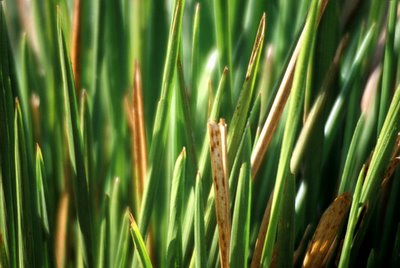
Here forms, here colours, here the character of every part of the universe are concentrated to a point; and that point is so marvellous a thing ... Oh! marvellous, O stupendous Necessity— by thy laws thou dost compel every effect to be the direct result of its cause, by the shortest path. These are miracles...
- Leonardo da Vinci





